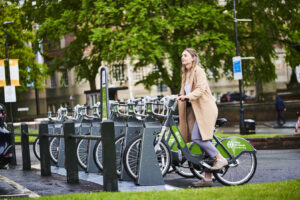Oxford reports drop in NO2 levels
Oxford has seen a ‘significant’ reduction in air pollution levels following the introduction of cleaner buses — but the city still has harmful levels of air pollution in some streets — the city council has reported.
Latest data from the city’s 74 air pollution monitoring locations has shown that levels of nitrogen dioxide (NO2) fell by an average of 22.7% between 2016 and 2017 — the largest ever year-to-year drop according to the council.

Oxford’s Zero Emission Zone proposals would see pollution emitting vehicles banned from Oxford city centre in phases
But four of the city’s air pollution monitoring locations still registered NO2 levels above the 40µg/m3 legal limit in 2017.
The new air pollution data is published in the city council’s Air Quality Annual Status Report, which provides an overview of annual averages for nitrogen dioxide levels across Oxford’s monitoring locations.
The reduction has been described as a significant step in the progress towards delivering zero emissions in Oxford city centre — which is to be backed by the introduction of a proposed ‘Zero Emission Zone’. This will ban diesel and petrol vehicles in stages between 2020 and 2035.
The fall in NO2 between 2016 and 2017 has been attributed by the council to Oxford Bus Company and Stagecoach Oxford introducing Euro VI standard vehicles into Oxford from 2014, but particularly in 2016 and 2017. About 40% of buses in city centre streets now meet the Euro VI standard, Oxford has said.
Funding
The council secured £1.7m of Government funding earlier this year to upgrade a further 78 buses to be ultra-low emission over the next 18 months — and convert five of Oxford’s sightseeing buses to become the city’s first fully-electric double-decker buses.
Councillor Tom Hayes, executive board member for a safer and greener environment, said: “There is no safe level of air pollution. When cities like Oxford slash pollution levels, fewer people suffer and die. But, put very bluntly, air pollution is an invisible killer, and Oxford must accelerate our pollution protection — especially in illegal parts of the city such as St Clement’s — because every day that we don’t, people will live in it, work in it and commute in it.
“Air pollution isn’t just an environmental concern. Nor is it simply a public health crisis. It’s a clear health injustice — everybody breathes the same air, but the poorest in our community and the very vulnerable are hit hardest by toxic pollution. As a council, we’re committed to ending all forms of inequality and all causes of inequality, and that means cleaning up our toxic air to end health inequalities in our city.
“Oxford is determined to eliminate air pollution from our roads once and for all and, with our Zero Emission Zone, accelerate the electric vehicle revolution which can nudge more drivers to trade in polluting cars for cleaner ones.”
Last week it was announced that air quality data specialist EarthSense is working with Oxfordshire county council and ‘connected vehicle’ company Tantalum to gain a better understanding of the impact of road traffic on dynamic air quality in the city.












